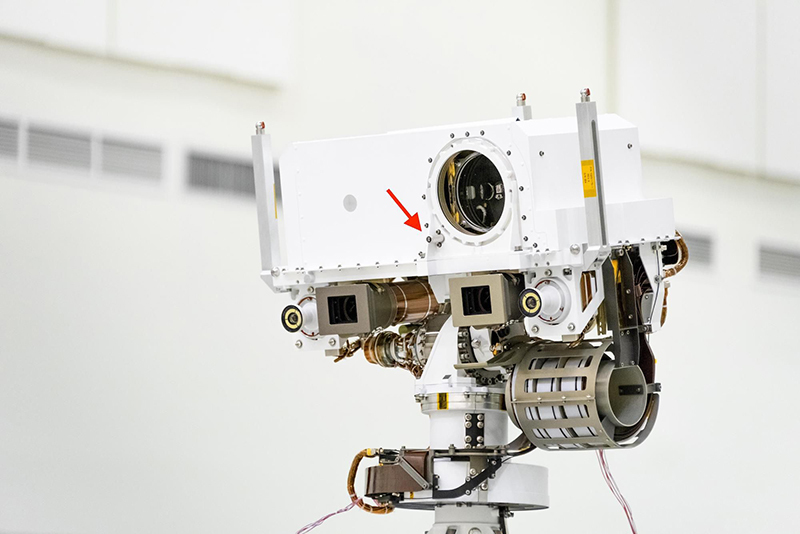Perseverance collects the first Martian sounds
Nasa’s Perseverance robot, which has been roaming the surface of Mars since February 2021, has recorded for the first time the “sound environment” of the Red Planet. An international team (1) led by a teacher-researcher from the University Toulouse III – Paul Sabatier and including scientists from CNRS and ISAE-SUPAERO published in Nature on April 1, 2022 the analysis of these sounds, obtained with the SuperCam instrument built in France under the authority of CNES.
A deafening silence. For 50 years, interplanetary probes have sent back thousands of striking images of the surface of Mars, but never a single sound. Nasa’s Perseverance mission has put an end to this sonic void by recording the first Martian sounds. The scientific team of the Franco-American SuperCam (2) instrument mounted on Perseverance was convinced that studying the soundscape of Mars could advance our understanding of this planet. This scientific challenge led to the design of a microphone dedicated to the exploration of Mars, at ISAE-SUPAERO in Toulouse.
Perseverance recorded for the first time the sound atmosphere of the red planet on February 19, 2021, the day after its arrival. These sounds are in the human audible spectrum, between 20 Hz and 20 kHz. First of all, they reveal that Mars is quiet, so quiet that the scientists thought several times that the microphone was not working. It is clear that, apart from the wind, natural sound sources are rare.
In addition to their analysis, scientists have been interested in the sounds generated by the rover itself (3): the shock waves produced by the impact of the SuperCam laser on the rocks or the flights of the Ingenuity helicopter. The study of the propagation on Mars of these sounds, whose behavior is perfectly known on Earth, allows to characterize the acoustic properties of the Martian atmosphere in detail.
Scientists have shown that the speed of sound is lower on Mars than on Earth: 240 m/s, against 340 m/s on our planet. But the most surprising thing is that there are actually two sound speeds on Mars, one for high frequencies and one for low frequencies (4) . The attenuation of sound is stronger on Mars than on Earth, especially the high frequencies which are lost very quickly, even at short distances, unlike the low frequencies. All these factors would make a conversation difficult between two people separated by only five meters. They are due to the composition of the atmosphere of Mars (96% CO2, 0.04% on Earth) and the very low pressure at its surface (170 times lower than on Earth).
After one year of mission, a total of five hours of sound environment recordings were captured. The in-depth analysis of these sounds has made perceptible the sound generated by the turbulence of the Martian atmosphere. The study of this turbulence, at scales 1000 times smaller than previously known, will improve our knowledge of the interaction of the atmosphere with the surface of Mars. In the future, other robots equipped with microphones could improve the understanding of planetary atmospheres.

Notes
- Scientists from the laboratories of the Institut de recherche en astrophysique et planétologie (Université Toulouse III – Paul Sabatier/CNRS/CNES), the Institut de mécanique des fluides de Toulouse (Université Toulouse III – Paul Sabatier/CNRS/INP), the Laboratoire d’études spatiales et d’instrumentation en astrophysique (Observatoire de Paris-PSL/CNRS/Sorbonne Université/Université Paris Cité), the Laboratoire atmosphères, milieux, observations spatiales (CNRS/Sorbonne Université/Université de Versailles St Quentin-en-Yvelines), the Institute of Mineralogy, Physics of Materials and Cosmochemistry (CNRS/MNHN/Sorbonne University), the Planetology and Geosciences Laboratory (CNRS/University of Nantes/University of Angers), the Institute of Planetology and Astrophysics of Grenoble (CNRS/University of Grenoble Alpes) the Centre Lasers Intenses et Applications (CNRS/CEA/Université de Bordeaux), the Laboratoire d’Astrophysique de Bordeaux (CNRS/Université de Bordeaux), the Institut d’Astrophysique Spatiale (CNRS/Université Paris Saclay), the Laboratoire de Géologie de Lyon : Terre, Planètes, Environnement (CNRS/ENS Lyon/Université Claude Bernard) and the GeoRessources laboratory (CNRS/Université de Lorraine)
- SuperCam was developed jointly by LANL (Los Alamos National Laboratory, USA) and a consortium of laboratories attached to CNRS and French universities and research institutions. CNES is responsible to NASA for the French contribution to SuperCam.
- The microphone is also a real stethoscope for the rover as it provides a sound diagnosis of its good health.
- Approximately 240 m/s for frequencies below 240 Hz, 250 m/s above
Further Resources
- Scientific article : First Sounds from Mars. S. Maurice, B. Chide, N. Murdoch, R. D. Lorenz, D. Mimoun, R. C. Wiens, A. Stott, X. Jacob, T. Bertrand, F. Montmessin, N. L. Lanza, C. Alvarez-Llamas, S. M. Angel, M. Aung, J. Balaram, O. Beyssac, A. Cousin, G. Delory, O. Forni, T. Fouchet, O. Gasnault, H. Grip, M. Hecht, J. Hoffman, J. Laserna, J. Lasue, J. Maki, J. McClean, P.-Y. Meslin, S. Le Mouélic, A. Munguira, C. E. Newman, J. A. Rodríguez Manfredi, J. Moros, A. Ollila, P. Pilleri, S. Schröder, M. de la Torre Juárez, T. Tzanetos, K. M. Stack, K. Farley, K. Williford, and the SuperCam team. Nature, le 1er avril 2022. DOI: 10.1038/s41586-022-04679-0
- Scientific communication : Sound Speed on Mars measured by the SuperCam microphone on Perseverance par Baptiste Chide et al.
- Premier enregistrement audio sur Mars (NASA)
- Press Reveiew :
- Mars : Perseverance a permis de calculer la vitesse du son sur la Planète rouge (Futura Sciences)
- Les premiers enregistrements sonores de Mars expliqués par David Mimoun (Futura Sciences)
- What Sounds Captured by NASA’s Perseverance Rover Reveal About Mars (NASA)
- Les premiers sons sur Mars (Université Paul Sabatier de Toulouse)
- Quelles nouvelles de Perseverance sur Mars? (RFI)
IRAP Contact
- Sylvestre Maurice, sylvestre.maurice@irap.omp.eu






